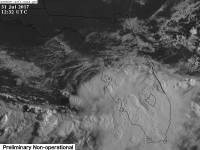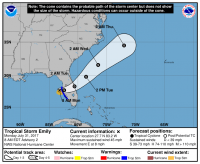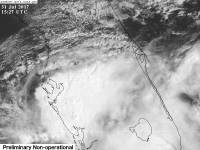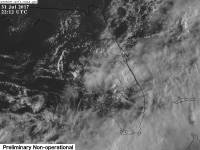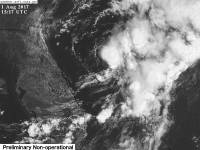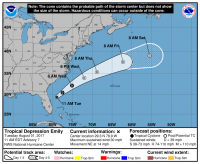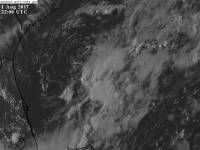Table of Contents
Tropical Storm Emily
Tropical storm Emily started out as Invest 98L, which formed in the Northeast Gulf of Mexico on July 29, 2017, as a low off of a cold front that dove into the Gulf, which is considered uncommon for the time of year. In the early morning of July 31, 2017, Tropical Depression 6 formed not far off the coast of the Tampa Bay area in Florida with sustained winds of 45 mph and a central pressure of 1008 mb.
At 8 am, it strengthened into Tropical Storm Emily with max sustained winds of 45 mph and a central pressure of 1006 mb.
This storm jumped from a low risk to a medium risk just before being named a depression, making it the fastest developed storm of the year as of its formation. It went from an invest, to a depression, to a tropical storm, to landfall in around 5 hours, making it one of or the quickest storms to develop and hit land.
After making landfall, the storm weakened to a depression with winds of 35 mph and a pressure of 1007 mb, rising to 1011 mb and the winds dropping to 30 mph after moving off land.
Early in the morning of August 2, 2017, Emily dissipated into a Post-Tropical Cyclone.
Impacts
Heavy rain is expected throughout Central Florida as a result of landfall, which is expected to be in the afternoon of July 31, 2017.
At 10:45 a.m. on July 31, 2017, Emily made landfall on Anna Maria Island with winds of 45 mph and a min pressure of 1005mb.
Heavy rain of up to 8“ fell across Central Florida and caused widespread flooding, and the winds caused some damage to roofs in the area. An EF-0 tornado touched down near Bradenton, Florida causing $96,000 worth of damage.
As the storm moved off the coast, rip currents were a threat along the Florida coast.
Which Model Won?
- ECMWF - Developed the system very weakly, but only had real development once in the Atlantic, so too late of development.
- CMC - Developed the storm in the right area, and maintained a low through the Atlantic after taking it up through the Southeast early on. However, it sniffed the storm first.
- GFS - Saw a weak low, but didn't do anything with it.
- NAVGEM - Also sniffed out the low, but didn't as much as the CMC, nor did it keep it alive and on the right track.
- NAM - Sniffed it out as soon as it could, and had proper pressure, though it went a little north early on.
- UKMET - N/A, but likely like the ECMWF.
- HWRF - Took the storm along proper path as soon as early initialization happened.
- HWRF-PARA - Took the storm North, instead of into the coast of Florida, then out to sea.
- HMON-PARA - Followed the same as the HWRF, but winds were slightly weaker, pressure as well.
End Result:
- Long range : CMC - The CMC Developed the storm first, making it better than the ECMWF, which was too late, and the GFS, which lacked development. The NAVGEM was close, but wasn't first and consistent. The CMC also got the track right closer, but was too far north initially.
- Short range : HMON-PARA - This model took a correct route and kept it weak after hitting Florida. It was only slightly better than the HWRF-PARA, which initially sent the storm North after formation.
- Strength : HMON-PARA - This model was just a hair above the other models as far a strength. The NAM was too strong, the HWRF and its PARA were both too weak.
